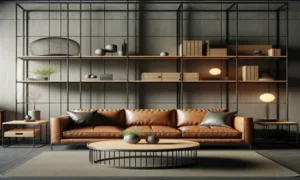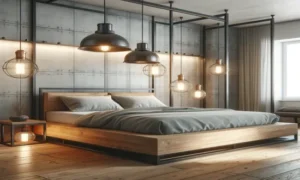Introduction
Welcome to the fascinating world of lean industrial design, an approach that revitalizes spaces with a contemporary and functional style. This concept combines industrial robustness with a minimalist aesthetic, creating environments that are not only visually striking, but also extremely practical. At a time when reuse and space efficiency are more relevant than ever, lean industrial design is emerging as a key trend in interior design. It allows us to rediscover and transform spaces, whether residential or commercial, into areas of utilitarian beauty, where every element has a purpose, and industrial charm is balanced with refined simplicity.
History and Origin of Industrial Decoration
Industrial decor has its roots in the post-industrial era, when disused factories and warehouses began to be transformed into living spaces. Originally characterized by raw elements and an unfinished feel, this style reflected the functionality and robustness of industrial environments. Over time, industrial decor has evolved, adapting to the needs of modern living. This is where the “lean” industrial style emerges, which maintains the essence of the original, but with a more polished and less cluttered feel. This evolution marked the transition from large and often underutilized spaces to more welcoming and efficient environments, where the industrial aesthetic is complemented by a cleaner and more organized approach, making it ideal for modern residential and commercial spaces.
Characteristics of Lean Industrial Decoration
Lean industrial decor is defined by its unique characteristics. Key elements include the use of raw, unprocessed materials such as metal, brick and wood, which lend a sense of robustness and authenticity. The color palette tends to be neutral, favoring shades of gray, black and white, which complement the natural materials. Textures are another important component, with rough, tactile surfaces adding depth and visual interest to the space. Compared to traditional industrial decor, lean industrial decor is more refined, avoiding excess elements and focusing on functionality and simplicity. This results in a perfect balance between industrial character and a welcoming environment, making it ideal for those seeking a modern aesthetic without sacrificing comfort and practicality.
Why Choose Lean Industrial Decor
Opting for lean industrial decor is a smart decision for a number of reasons. First, it’s a big draw. This style favors the use of recycled or repurposed materials and furniture, which can be significantly more affordable than other decor options. Plus, it’s remarkably adaptable. Regardless of the size or layout of the space, lean industrial decor can be easily adjusted to suit different settings, making it a versatile choice for any space. Aesthetics are another strong point: the mix of raw elements and clean lines creates a unique, contemporary look.
In practical examples, we see lofts and studios where lean industrial decor maximizes the feeling of spaciousness, even in limited areas. In larger spaces, the strategic arrangement of industrial furniture and accessories helps to create distinct zones without the need for walls, preserving the feeling of openness and flow.
Practical Tips for Implementation
To implement lean industrial decor, start by carefully selecting furniture and accessories. Opt for pieces with simple lines and sturdy construction. Materials such as iron, steel, recycled wood and concrete are ideal. Multi-functional furniture, such as sofa beds or expandable tables, are also excellent choices, especially in smaller spaces.
The choice of colors and textures plays a crucial role. Opt for a neutral color palette – grays, blacks and whites are typical of this style and provide a perfect backdrop for highlighting industrial elements. In large spaces, darker tones can be used to create a sense of coziness, while lighter tones can give the illusion of more space in smaller areas. Textures are important for adding depth and visual interest; think exposed brick walls, concrete floors or reclaimed wood.
Strategic lighting is key. Industrial-style lighting fixtures not only complement the look, but also offer the flexibility to adjust lighting for different functions within the space. Use a combination of general, task and accent lighting to create different moods. For example, metal pendant lights above a dining table or directional lighting to highlight specific artwork or architectural features.
By following these tips, you can create a space that not only reflects the beauty of lean industrial decor, but is also practical and adaptable to your everyday needs.
Transforming Different Spaces
Lean industrial decor can dramatically transform any room in your home, from the living room to the kitchen and bedrooms. In the living room, consider incorporating clean-lined leather sofas and metal or recycled wood coffee tables. Add open metal shelving for a sense of space and functionality. In the kitchen, industrial-style cabinets with metal finishes and concrete countertops can create a sophisticated yet practical look. Center islands with sturdy surfaces are perfect for open-plan kitchens. For bedrooms, opt for metal or wood platform beds and use industrial-style light fixtures for lighting.
Ex: Room

Ex: Kitchen

Ex: Room

One example of a transformation is a living room that was once cramped and cluttered, but after a lean industrial makeover, it becomes an open and welcoming space. Traditional kitchens can be transformed into modern and functional spaces with streamlined cabinetry and central islands. Bedrooms can transform from merely functional spaces into calming and stylish retreats.
Common Care and Mistakes to Avoid
When adopting lean industrial decor, it’s crucial to maintain a balance between industrial elements and comfort. Avoid overwhelming the space with metal and concrete; moderation is key. Include softer elements, like rugs and pillows, to add warmth and comfort.
A common mistake is neglecting lighting. Industrial decor requires good lighting to highlight its unique elements. Another thing to watch out for is avoiding a look that’s too “unfinished.” While raw elements are a hallmark of this style, it’s important to make the space feel livable and welcoming. Also avoid clutter; the lean industrial style values simplicity and open space, so choose each piece carefully and avoid piling on too many decorative items.
Remember, the goal is to create a harmonious balance between industrial and cozy, while keeping the space functional and aesthetically pleasing.
Conclusion
At the end of this journey through the world of lean industrial decor, we’ll revisit the essence of this unique style: a perfect combination of functionality, minimalist aesthetics, and a neutral color palette. The practical tips we’ve covered, from carefully choosing furniture and accessories to implementing strategic lighting, are the foundation for transforming any space, be it a living room, kitchen, or bedroom, into a modern and welcoming environment. Remember to maintain a balance between industrial elements and comfort, avoiding common mistakes that can compromise the final result.
We hope this information inspires you to start your own decorating projects. With creativity and a little planning, you can create a space that reflects your personality and meets your needs, all while embracing the elegance and simplicity of lean industrial decor.
